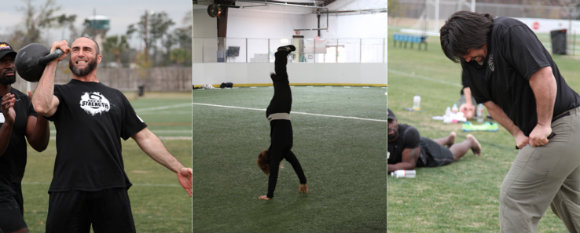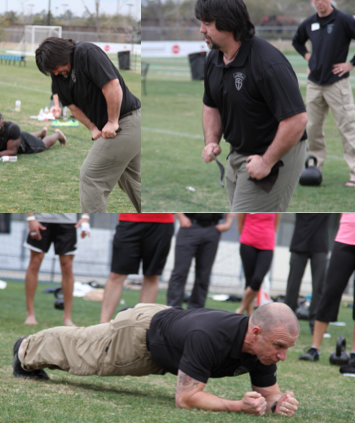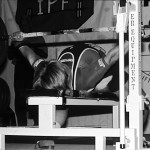There are two types of training a strength seeker must do:
- Perform a number of sets with moderate weights and reps, e.g. 5×5. This builds muscle and “greases the groove.”
- Develop your tension skills—the ability to tense individual muscles and to link them into an unbreakable chain.
The first component, volume, is not greedy for variety. Many athletes have built world-class strength and muscle mass by sticking to the same battery of basics like the three powerlifts. (Some variety does not hurt, but not on the day-to-day basis. Switch your bench press grip or move to an incline bench and you are good for another six weeks.)
The second component, tension, thrives on frequent exercise changes. Consider the Westside Barbell Club practice of changing to a different variation of the bench press on their “max effort day.” Consider the wealth of gymnastic tightness exercises, each teaching another subtlety of turning your body into a piece of steel.
Enter the Tension Day, a simple model for implementing tension practice in almost any strength regimen, regardless of your goals and preferred training implement.
Exercise Selection for Tension Day
During the week, build what Russian coaches call a “foundation” with multiple sets of five, give or take a rep. Depending on the exercise and individual circumstances (time available, recovery, other physical demands), the frequency will typically vary between once a week to three times a week.
Saturday is your Tension Day.
Take a close look at the exercises listed below. What do they have in common?
- Double kettlebell front squat
- Double kettlebell static stomp deadlift
- Heavy kettlebell clean
- Heavy kettlebell quarter get-up
- Bottom-up kettlebell drills
- Kettlebell renegade row
- One-legged kettlebell press
- Tight rope kettlebell press
- Around-the-body kettlebell pass or “slingshot”
- One-legged single or double kettlebell deadlift
- Power breathing
- Hard style sit-up
- Hollow rock and other hollow position drills
- Muscle control exercises
- Yang plank
- One-arm pushup progressions
- One-arm lock-off
- One-arm hang (extra weight in free hand, the working shoulder packed)
- One-arm handstand (wall-supported)
- Walking on hands
- Zercher squat
- Suitcase deadlift
- Back squat, bench press, and deadlift overloads: lockouts, walkouts, supports.
All these exercises, regardless of the implement, develop tension skills in one way or another:
- Some do it the brute force way—through more weight. Examples are a deadlift rack pull, a clean performed with a kettlebell you cannot yet press, and the one-arm lock-off (holding the top position of the one-arm pullup).
- Others do it through a stabilization challenge: bottom-up kettlebell drills, the one-arm one-leg pushup, the one-legged kettlebell press.
- There are pure feed-forward drills demanding that you generate tension out of nothing, such as gymnastic hollow rocks and the Yang plank.
- There are combined feed-forward and feed-back moves like the double kettlebell front squat and the renegade row.
Regardless of the implement or the underlying mechanism, all these drills teach you one thing: to get tight.
1,000-pound deadlifter Andy Bolton has spoken: “The strong guys all have one thing in common—they know how to get tight. Without tightness, you cannot have strength. All the best lifters get tighter than the average lifters. Simple as that.”
So on Saturday select several exercises from the list—say three—and practice your tension skills.
Guidelines for Tension Day
Pick some drills specific to the lifts you aim to improve, e.g., one-arm lock-offs for weighted pullups.
Pick others that are more general in nature, e.g. hard style sit-ups for a powerlifter. (For a gymnast it would be a drill highly specific to the hollow position extensively found in the sport. For a lifter it is just a way to get tighter overall.)
Some should get your attention through heavy weights, others through stabilization, etc.
Make sure at least one exercise is unilateral.
Stay around 110% 1RM for barbell overloads. Heavier weights are dangerous and less effective.
Do not even think about one-arm handstands until you are strong enough to do several handstand pushups between boxes. Ditto for one-arm lock-offs and hangs until you can do a strict pullup with an additional 50% of your bodyweight.
Avoid redundancies. For instance, there is no point in these pairs: hard style sit-up + hollow rock; Zercher squat + double kettlebell front squat; one-arm handstand + bench press support, etc.
But do not overthink your selections either, because every three weeks you get to change them.
Some examples:
- Double kettlebell front squat
- Walking on hands sideways along the wall
- One-arm hang, the shoulder packed
- Barbell back squat walkout
- Heavy kettlebell clean
- Hard style sit-up
- Heavy kettlebell quarter get-up
- Deadlift lockout
- Power breathing
How to Train on Tension Day
Start your Tension Day with whatever warm-up or lack of thereof that you know to be safe and effective for you. Then perform three moderately hard sets per exercise. Keep your reps low, 1-3. Keep isometric contractions in the 5- to 10-second range. Rest for several minutes between sets, walking around and doing fast and loose drills.
Finish stronger than when you started. It is extremely important you understand that what you do on Saturdays is a practice—not a test! If you have to psych for whatever you are about to do, you are going too far.
You are aiming to feel strong and tight—not crushed. An optimally heavy weight maximizes muscle tension. An ego-driven poundage makes muscles quiver and shut down. Even your mother does not care what your heaviest deadlift lockout is; so do not go there.
Back-off sets, “finishers,” and “smokers” do not belong on your Tension Day. Wrap up with an extensive thirty- to 45-minute stretching and relaxation practice that includes hanging on a pullup bar. Dr. Franco Columbu has warned, “Compression is the worst enemy of a strength athlete.” Enjoy working both extremes of your muscles’ ability—tension and relaxation—and you shall find strength and health.







Thanks for this very instructive article! I just discovered this website and it’s amazing!
This article is pure evil! Thanks Pavel!
Nice article. What constitutes a 1/4 get-up?
Chris, to your elbow.
Thank you, Aleks!
This is a really fantastic post. I’ve found that the more I’ve stripped down sets and reps and just focused on generating tension in any given exercise, the better I inevitably do. The idea of taking a few exercises different enough from one’s current program and practicing them on a separate day sounds like training gold. I’ll get started ASAP.